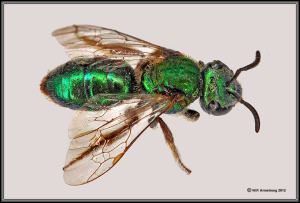Identification
As you may have guessed already, sweat bees get their name from their unique attraction to the salt in perspiration and have been known to land on people to “lick” the sweat off. Not to worry though if one lands on you! These bees are not aggressive and are just looking to absorb some nutrients. Sweat bees are small (1/4 to ¾ inches in length), solitary insects that have a wide variation in coloration depending on the species: dull or metallic black to metallic green, blue, or purple. They are also major pollinators of wildflowers and commercial crops, such as stone fruits and sunflowers.
Biology
Depending on the species they will overwinter in their nest as prepupae or adults. In the spring the females will mate and search for a new nest site. Sweat bees are primarily ground nesters, but some species will nest in rotting wood. Once the foundress bee has excavated her nest, she will then collect pollen and nectar to use as provisions for her brood. A mixture of pollen and nectar is placed in each brood cell along with an egg before the cell is closed.
Some species of sweat bees are parasitic, meaning that they won’t build their own nest. Rather the parasitic species will find another bee’s nest, kill the eggs already there, and will then lay their eggs. The non-parasitic bee will care for these eggs, thinking that they are raising their own offspring.


